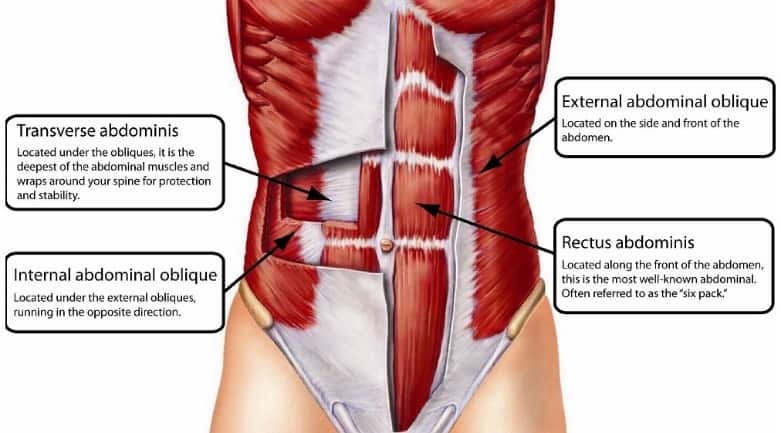‘Strengthen your core’ is a common recommendation from exercise professionals, physical therapists, doctors, surgeons and researchers, for an array physical concerns [1, 2]. It’s also a catch phrase for many exercise programs. But what does it mean?
It refers to specific core muscles of the body that essentially work to stabilise, support and protect the spine. The health and movement benefits of strengthening core muscles and their function are numerous, and well supported by research, however problems can arise if ‘core training’ is not specific to different ‘core muscle’ systems and functions [1, 2].
The appearance of “wash-board” shaped abs does not necessarily indicate a strong core. I’ve had many larger clients, who are far stronger than smaller gym-bunnies we see in the studio from time to time.
Both your brain and your muscles need to be focused and engaged in effective core training and the good news is Pilates, when taught professionally, addresses and develops these concepts [1-3, 6].
The ‘deep’ versus the ‘superficial’ core and what do they do?
Without going into a tedious anatomy lesson ‘the core’ comprises a deep intrinsic system of muscles [transverse abdominis, multifidus, pelvic floor and diaphragm) and a more superficial system [1, 4, 5] which among others includes your 6-pack muscles – yes, we all have them!
They are referred to as “local” and “global” systems respectively. Ideally the deeper local system switches on just before you start to move, to stabilise the spine, then the superficial global system provides reinforcement to deal with any extra loads from moving bones and limbs.
When all is going well these two systems, working together, should:
- protect and support the spine
- contribute to better posture
- prevent or reduce pain
- improve faulty movement functioning
- assist in prevention and rehabilitation of a swag of physical injuries and conditions; and,
- help improve athletic performance
[1-4, 6]
How to Train your Dragon Core
If you get serious about core strengthening, you will need to focus on the deep local muscle systems first.
Once these are functioning correctly, you bring in the big boys – the global muscle system (that give the sculpted appearance) – with increased loads and integration of multiple spinal and/or limb movements.
Unfortunately, specific training on the deeper core muscles is not as easy as you might think. You need to be very focused and even then, it can tricky to sense what’s going on in your own body. The bigger challenge can be more in keeping unnecessary global muscles off, rather than turning the deeper ones on [1], especially for those who are or have been very active or have dealt with major injuries or conditions.
In initial stages of core strength training, you may not ‘feel the burn’ in the abdominals (you will …. just not yet). If you do, your body is probably cheating in some way. Like learning anything new, you will need to do ground work first, even though it seems less interesting, to be able to do the more exciting stuff properly and safely later.
A professional movement instructor or specialist should be able to guide you through the fundamentals of core training and teach you how to detect and respond correctly to compensations in your body.
Fun facts – The deep core muscles:
- are the closest to the spine and their primary job is to stabilise it
- don’t move any bones when contracting and you won’t see them switch on or off from the outside
- do their job best when the spine is in a good alignment (known as the neutral spine position) and require little physical effort (in fact they only need to contract at 25-30%).
- will not stay switched on for very long – bad news for dedicated ‘Plankers’, your deep abdominal muscles will only active for a maximum of 8-10 seconds, after that you are cheating.
- will not activate properly if you are not breathing (ie holding your breath)
- may be inhibited if pain is present (e.g. lower back pain may reduce the ability of deep core muscles to activate)
[1, 2, 4, 5]
Why Pilates gets the core!
‘I don’t know what Pilates is, but I’ve been told it’s good for my core …. ‘
If only I had a dollar every time I’ve heard this from new clients!
One of the key governing concepts of Pilates is control of movement. To control the movement of anything in an ongoing a sustainable way, it needs to have strong foundations (local and global core systems) allowing the other parts (ie arms and legs) to be free to move, and do what they are supposed to do safely.
Ideally all this happens in the body without:
- gripping of muscles or joints getting stuck or inflexible.
- body parts swinging off to places you can’t control (eg spinal vertebrae, pelvis, limbs)
- moving incorrectly (thus less efficiently)
Good Pilates is based on these concepts and progressively teaches you to stabilise the spine and pelvis, work with extra loads or resistances, and move the torso and limbs as far as you can control safely (and in that order).
Taught professionally Pilates, with regular practice (at least once a week) will very likely help to strengthen your local and global core systems.
A word of warning, particularly for those with physical injuries or specific conditions – not all exercise classes or instructors will address core training so specifically and it is worthwhile getting professional advice and recommendations just to be on the safe side.
Written by Lizzi Webb for Encore Pilates and Wellness, 2018

